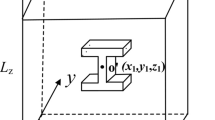Abstract
The effective thermal conductivity of composites with ellipsoidal fillers is analyzed by using a homogenization method that is able to represent the microstructure precisely. In this study, various parameters such as the volume fraction, shape, and distribution of the filler are quantitatively estimated to understand the mechanisms of heat transfer in the composite. First, thermal boundary resistance between resin and filler is important for obtaining composites with higher thermal conductivity. Second, the anisotropy of the effective thermal conductivity arises from contact between filler in the case of ellipsoidal filler and produces lower thermal resistance. Finally, the filler network and thermal resistance are essential for the heat transfer in composites because the path of thermal conduction is improved by contact between neighboring filler particles.
Similar content being viewed by others
References
W. Zhou, Q. Chen, X. Sui, L. Dong, Z. Wang, Enhanced thermal conductivity and dielectric properties of Al/β-SiCw/PVDF composites, Composites Part A: Applied Science and Manufacturing, 71 (2015) 184–191.
B.L. Zhu, J. Wang, H. Zheng, J. Ma, J. Wu, R. Wu, Investigation of thermal conductivity and dielectric properties of LDPE-matrix composites filled with hybrid filler of hollow glass microspheres and nitride particles, Composites Part B: Engineering, 69 (2015) 496–506.
Z. Gao, L, Zhao,. Effect of nano-fillers on the thermal conductivity of epoxy composites with micro-Al2O3 particles, Materials & Design, 66(A) (2015) 176–182.
Y. Yao, X. Zeng, K. Guo, R. Sun, Jb. Xu, The effect of interfacial state on the thermal conductivity of functionalized Al2O3 filled glass fibers reinforced polymer composites, Composites Part A: Applied Science and Manu facturing, 69 (2015) 49–55.
J. Schuster, D. Heider, K. Sharp, M. Glowania, Thermal conductivities of three-dimensionally woven fabric composites, Composites Science and Technology, 68 (2008) 2085–2091.
EB. Wei, YM. Poon. Effective thermal conductivity of graded nonlinear composites with heat contact resistance. Physics Letters A, 359 (2006) 685–692.
R. Kothari, CT. Sun, R. Dinwiddie, H. Wang, Experimental and numerical study of the effective thermal conductivity of nano composites with thermal boundary resistance, International Journal of Heat and Mass Transfer, 66 (2013) 823–829.
BR. Wang, JT. Liu, ST. Gu, QC. He, Numerical evaluation of the effective conductivities of composites with interfacial weak and strong discontinuities, International Journal of Thermal Sciences, 93 (2015) 1–20.
EB. Wei, JB. Song, JW. Tian, Thermal conductivity of graded spherical composites with contact resistance, Physics Letters A, 319 (2003) 401–405.
JJ. Gou, H. Zhang, YJ. Dai, S. Li, WQ. Tao, Numerical prediction of effective thermal conductivities of 3D four-directional braided composites, Composite Structures, 125 (2015) 499–508.
W. Leclerc, N. Ferguen, C. Pélegris, E. Bellenger, M. Guessasma, H Haddad, An efficient numerical model for investigating the effects of anisotropy on the effective thermal conductivity of alumina/Al composites, Advances in Engineering Software, 77 (2014) 1–12.
Y. Asakuma, T. Yamamoto, Thermal analysis of porous medium with ellipsoidal pores using a homogenization method, Heat and Mass Transfer, accepted HAMT-D-15-00053.
Y. Asakuma, Y. Kanazawa, T. Yamamoto, Thermal radiation analysis of packed bed by a homogenization method, International Journal of Heat and Mass Transfer, 73 (2014) 93–102.
A. Matine, N. Boyard, G. Legrain, Y. Jarny, P. Cartraud, Transient heat conduction within periodic heterogeneous media: A space-time homogenization approach. International Journal of Thermal Sciences, 92 (2015) 217–229.
I. Sevostianov, G. Mishuris, Effective thermal conductivity of a composite with thermo-sensitive constituents and related problems, International Journal of Engineering Science 80 (2014) 124–135.
J. Gudmundsson, M. Hammar, M. Kreveld, Higher order Delaunay triangulations. Computational Geometry, Theory and Applications, 23 (2002) 85–98.
Author information
Authors and Affiliations
Rights and permissions
About this article
Cite this article
Asakuma, Y., Yamamoto, T. Thermal analysis of resin composites with ellipsoidal filler considering thermal boundary resistance. J. Therm. Sci. 25, 424–430 (2016). https://doi.org/10.1007/s11630-016-0880-9
Received:
Published:
Issue Date:
DOI: https://doi.org/10.1007/s11630-016-0880-9




